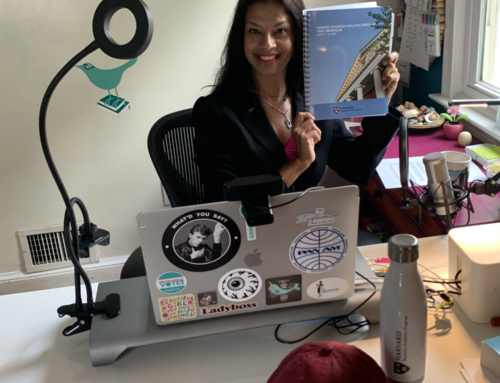 When I decided to hire a virtual assistant, I had no idea how much I’d learn from the process.
When I decided to hire a virtual assistant, I had no idea how much I’d learn from the process.
Here’s the story:
As you know, I’ve relaunched my business (new website coming soon, I’m so excited to share it with you!) and have very specific areas I want to grow it in.
I’ll tell you more about those later, but there were a couple of things I realized when I made the decision to dust off my entrepreneurial shoes:
1. I needed to have a system with which to track, develop and maintain new business relationships – hence my exhausting search for a small business CRM system that would work the way I needed it to; and
2. I needed help with certain elements of my business, particularly on the administrative and marketing side of things. Do you have any idea how long it takes to do much of the nitty-gritty an entrepreneur has to deal with, as well as how long those tasks can take, particularly the marketing tasks?
Image: Freddie H. via Flickr, CC 2.0
Now, “marketing” is what I do. So when it comes to my business, it had better be good. Else baby won’t get a new pair of shoes!
Enter oDesk
I looked around, checked out various VAs I heard about, and then decided to place an ad on oDesk. I’d heard good things about it from a few different friends and fellow women entrepreneurs (Donna Vincent Roa and Tinu Abayomi-Paul, to name just a couple), and they seemed to have a pretty solid system.
So I posted a job opening. I made it as detailed as I could; I specified certain skills, how much I was willing to pay, etc., I was looking for. Before I could even count to 10 – ok, maybe 79 – the applicants started rolling in.
Over a period of a couple of weeks, there were 27 applicants. Most of them ignored at least some of the specifics of my posting. Many had frighteningly high opinions of their language skills, and some applied even though they would be incapable of using certain platforms I needed them to.
When I did shortlist candidates – I think six or seven – I asked them to follow a specific process to set up a Skype interview with me. It was easy enough (at least, I thought so): I gave them my Timebridge link and asked them to send me a couple of options for a chat.
Guess how many did exactly as I asked?
One.
Just one.
And the others?
Here beginneth the lessons
Well, there was the one candidate who couldn’t figure out how to use Timebridge, and kept asking me for help.
Lesson #1: if your potential client wants you to use a particular piece of software, or platform, you better figure out how to use it … without asking the client for help.
Then there were the candidates who were in China. Very eager, but unable to use Twitter. Or Google.
Which would make working on the social media marketing side of things difficult. No. It would make it impossible!
Lesson #2: if your physical or geographical (or any other -cal) circumstances preclude you from working with platforms the client needs you to… why should they hire you?
Then there were the candidates who completely ignored specific do’s and don’ts – e.g. I did not want anyone working for an agency to apply, but they did anyway. And I may have considered them if they fit the other criteria, but they didn’t.
So they were doubly irritating.
Lesson #3: it’s one thing to be ambitious in your reach, but the job specs are the job specs. And either you match, or you don’t; if you don’t, you’re far better off focusing on finding what is a good match for you.
The person I ended up hiring was a bit of a surprise.
I thought I might find someone in the far east, because of my small budget, but I actually found someone right here in the U.S. I’m also paying more than I originally wanted to (still within my overall business budget, though, so I am being a stickler about that, I have to).
Because, after talking to her, I believed she’d be worth it, and someone I could work with over the long haul.
Lesson #4: the right person for the job might be someone completely different to the image you had in mind. The same goes for PR agencies, business partners and strategic partners. Keep an open mind.
Something else I hadn’t anticipated happened. I got a few emails – not applications via oDesk, but direct emails – from virtual assistants who must have seen the job posting, checked me and my company out, and decided to write in personally.
Every single one of these was personable and while I didn’t hire them, I am in touch with at least a couple who I may end up working with on different types of projects – maybe even client work – as I grow the business.
Lesson #5: you never know where your next client might come from. “Cold calling” can still work, but only if it’s done right.
I’ve been working with my VA for close to a month now. While it’s early days yet, she is smart, eager to learn, takes direction well, and is teaching me a thing or two herself (anyone tried Join.me for screen sharing, now that Skype doesn’t let you do that without a premium account? It’s awesome!). She is conscientious about work, time (both when it comes to time sheets as well as learning some elements of the job on her own time) and someone I lean on just a little bit more every day.
And she better not get a big head as she reads this, Karelyn. Heh!
And the lessons I’ve learned along the way will be invaluable as I take SBC Inc. to the proverbial next level.
What about you? Have you gleaned business insights from places you wouldn’t expect? And speaking of VAs, do you have tips on working well with them? That could be a future post, so I’d love to get your thoughts. You know where to drop them… down there, in the comments section!









[…] of you know I recently started working with Shonali as her virtual assistant. Well, I’m excited to share my first project with you: getting to know those of you who are […]
[…] long-term webmaster is leaving for greener pastures ”” Sniff! ”” which has left me searching for help from, among other resources, oDesk. Here’s what I’ve […]
When I was new to hire http://www.systemsjunction.com/our-services/web-solutions/hire-dedicated-resources/ I was confuse and I had many questions in my mind like How To pay? How to hire? What about trust? But Now I am happy that i have VA.
[…] long-term webmaster is leaving for greener pastures ”” Sniff! ”” which has left me searching for help from, among other resources, oDesk. Here’s what I’ve […]
http://coachmarketingninjas.com from other countries are “in” right now. One tip I can give you is to start off by setting expectations with your VA. I think this would help the both of you to be on the same page when you discuss your future plans. :)
This is a great article on the positive experience in hiring virtual assistants. Those businesses who are having second thoughts about such will surely find this post informative. Thank you for sharing.
Thanks for sharing your positive experience with a virtual assistant. Many small business owners are hesitant about hiring someone whom they cannot physically watch work. Success stories like yours help spread the word that hiring a virtual assistant can work.
In this article that are given by the fully detailed concept about you are increase your site rank like as Over a period connected with several months, there were 30 job seekers. Many of
them overlooked at the least some of the details connected with my placing.
Several experienced frighteningly higher thoughts of their vocabulary abilities,
and several used despite the fact that they might end up being incapable
connected with employing several podiums Post essential them to.
Thanks…………………………….///
<br><a href=”http://www.superioreducationz.com/”>Education Information</a>
The whole concept of hiring a VA sounds really cool to me. Loved the post shonali ….there is just so much to learn from people across the world! Cheers to the new VA on board – karelyneve !! :)
Ancita It’s great having karelyneve on board!
The whole concept of hiring a VA sounds really cool to me. Loved the post @shonali ….there is just so much to learn from people across the world! Cheers to the new VA on board – karelyneve !! :)
The whole concept of hiring a VA sounds really cool to me. Loved the post @shonali ….there is just so much to learn from people across the world! Cheers to the new VA on board – karelyneve !! :)
I’ve thought about hiring a VA, but I don’t know how comfortable I feel with Odesk or something similar. I do like how you laid out here what you had to go through to find the right person. Good to know for the future.
susansilver Yes, I know exactly what you mean. But after tinu and DonnaVincentRoa shared their experiences with me, I felt better about oDesk. And like Donna says, there is a great deal of accountability built into the system. I also found them very responsive when I had questions, and there was no hard sell at all. So I liked that.
Great article.Thank you for sharing.Really nice stuff.
http://superioreducationz.com
<br><a href=”http://www.superioreducationz.com/”>Education Information</a>
@ericamallison @bowden2bowden @spinsucks Thank you for sharing! @alpmic Yea! Thanks to @martinwaxman for sharing too!
@shonali my pleasure, see you at # SoSlam
@bowden2bowden Yes indeed!
@martinwaxman @shonali A Virtual Assistant?! Never even knew-have to get out from under my rock more. Thks
@alpmic LOL, at some point, at least. :)
Shonali, glad to hear you found your prince(ss) among the frogs.
I’ve been lucky to not only have someone from oDesk with the virtual assistant experience/expertise, but one who has the background in water as well. He has a Masters in Water Resources Management and can take my water-related assignments and run with them.
oDesk is my hero for more reasons than one. I like the accountability built into the system. I did have to kiss a few frogs, too, but the gems rose to the top, and I am still working with them.
I mentioned oDesk at the IABC Independent’s meeting on Tuesday (and also mentioned your name for being an expert in social media). I think all small businesses should know about it.
See ya Monday xpotomac geofflivingston
DonnaVincentRoa The accountability is terrific! karelyneve is my Woman Friday (I literally used that term in my job posting) and it makes a huge difference. I can’t thank you enough for pointing me that way.
Also, thank you for mentioning me at the Indies group – that was so kind of you! Yes, excited to see you on Monday – will you be meeting geofflivingston for the first time or do you two already know each other? Some other cool people I’m excited to introduce you too are tinu jillfoster … oh, many more!
Hi DonnaVincentRoa, I look forward to meeting you at xPotomac, and reuniting with @shonali tinu also. Gentle warning: mischief makers we three are. Shonali: congrats on everything and this cracked a cackle: “So when it comes to my business, it had better be good. Else baby won’t get a new pair of shoes!”
Jillfoster OMG you just reminded me we never saw DonnaVincentRoa at xPotomac yesterday! tinu
@martinwaxman @xpotomac @leaderswest Thank you very much for sharing!
Shonali Burke, I’m glad you are happy with my work. Thank you for the opportunity you have given me to learn and grown with you.
karelyneve Now you know why I went into such detail in my posting, etc. – and as I said (and you know) I am definitely enjoying working with you. I really hope this continues to be a long and outstanding relationship, and that you are getting as much (at least) out of it as me!
@shonali @Tinu @donnavincentroa Ha! I was gonna ask how this was working out….
@ideaguypcam And now you know! @Tinu @donnavincentroa
Sounds like my hiring a PR pro series. You know some of my recent trials and tribulations and one thing my friend has tried doing is hiring on the cheap and fast for help such as what you were seeking. Mostly on Craigslist. But there has been turn over. Interns have no buy in. And if you pay someone $12/hr they are going to be gone as soon as something else comes along. In California minimum wage is $10 so a job at McDonald’s pays as much. A waiter makes a ton more. So if you are wanting someone with real admin and reasonable web skills it is hard to find at that rice.
I helped her go through resumes. Amazing how many didn’t follow the ad’s instructions! Well she has someone who looks like a keeper now but the journey for this started in August. And I think anyone who might interact with clients should be hired not quickly but with proper exploration and forethought!
So excited for you Shonali and great tips because I hope I will be needing help such as you have sometime this year.
HowieG So funny, I was thinking of your series while writing this post! One of the reasons I tried oDesk was because of the lower rates posted by many of the folks who use it. Obviously the lower I can keep my overheads, the better for my business. But many of those people are in the Far East, because what $5 an hour can do there is very, very different to what it can do here.
But they just didn’t have the skills I needed. Certainly there is an element of training involved as well – right karelyneve ? :) – but there’s a huge difference in getting someone up to speed when they already have good skills *and* language to start with, and when they don’t.
Thank you very much, Howie – I’m excited to be walking this path and very much hope that you will be soon too!
@shonali. Yes, I definitely have learned a lot and look forward to continuing this journey with you :)